Corporate Social Responsibility Impact on Indigenous Australians' Land
VerifiedAdded on 2020/07/22
|8
|2052
|35
Report
AI Summary
This briefing paper examines the impact of Corporate Social Responsibility (CSR) on environmental sustainability, focusing on its relationship with Indigenous Australian people and their connection to the land. The paper begins with a background on Indigenous Australian cultures, including the concept of 'The Dreaming' and their traditional land management practices. It then explores the historical context of colonization, policies, and legislation that have impacted Indigenous communities, leading to socio-economic disadvantages. The current position of Aussie Wanderer, a tourism organization, and its CSR activities are analyzed, highlighting its efforts in environmental protection, Indigenous employment, and cultural preservation. Recommendations are provided for Aussie Wanderer to enhance its CSR practices, including protecting sacred sites, supporting cultural centers, promoting Indigenous culture, increasing Indigenous employment, raising environmental awareness, and developing renewable energy sources. The report concludes with a list of references.
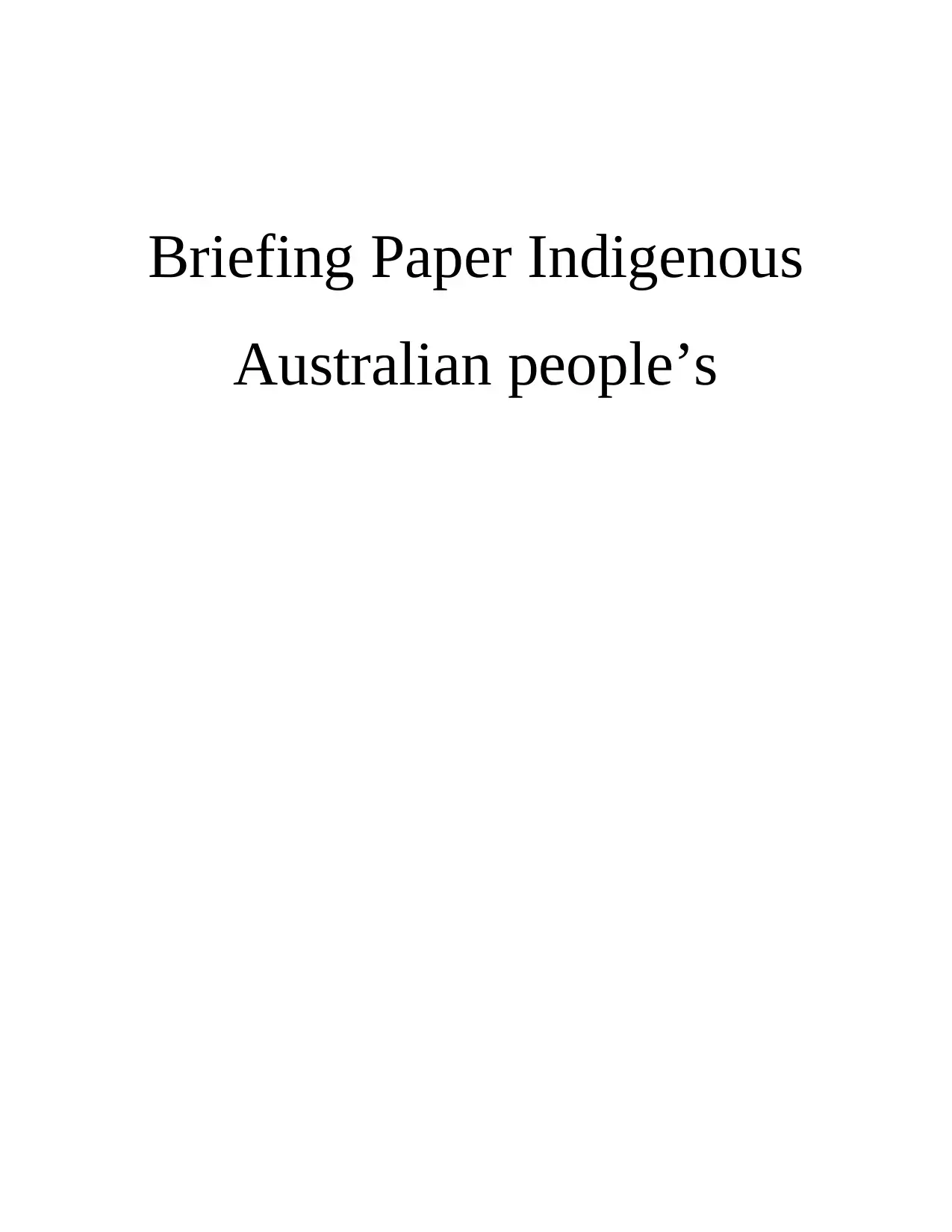
Briefing Paper Indigenous
Australian people’s
Australian people’s
Paraphrase This Document
Need a fresh take? Get an instant paraphrase of this document with our AI Paraphraser
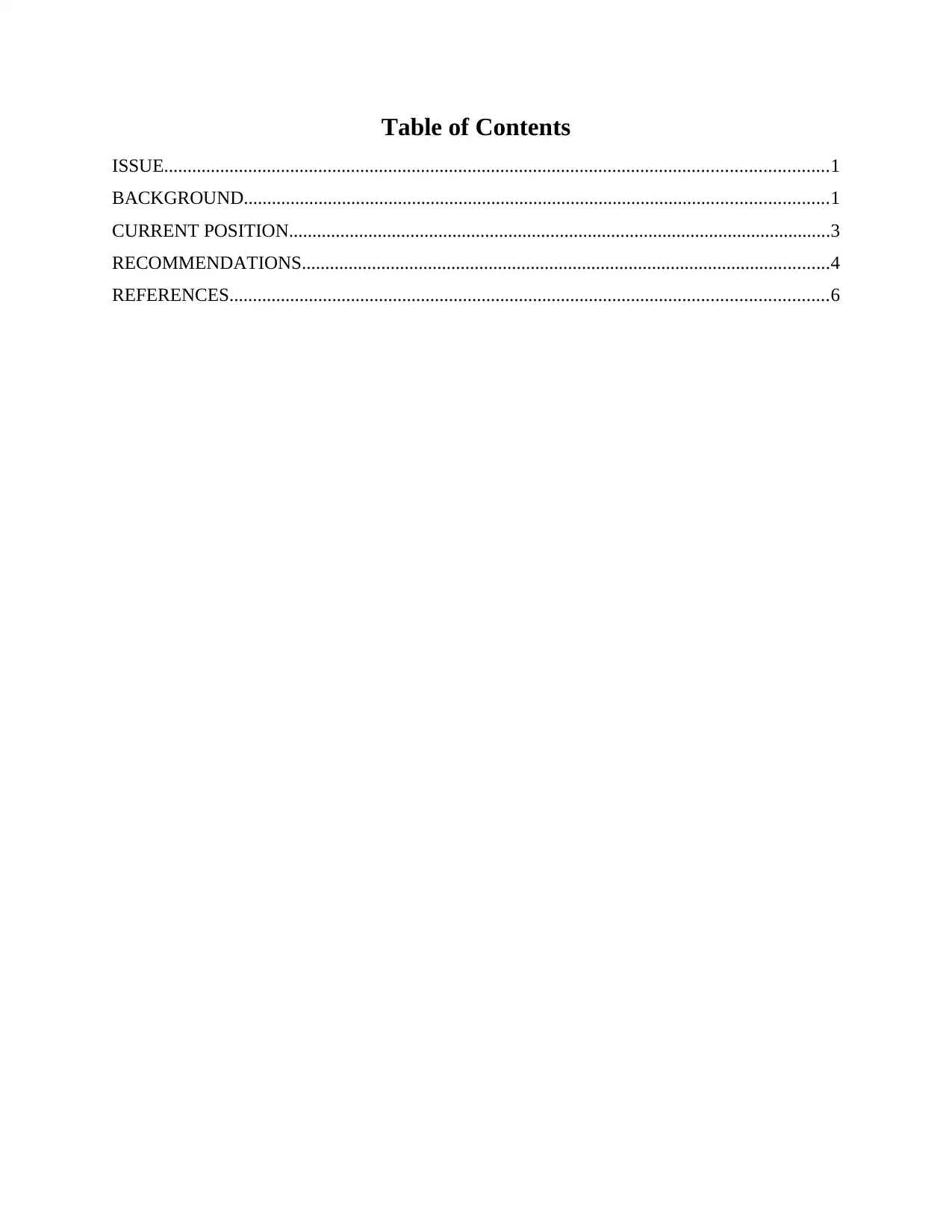
Table of Contents
ISSUE..............................................................................................................................................1
BACKGROUND.............................................................................................................................1
CURRENT POSITION....................................................................................................................3
RECOMMENDATIONS.................................................................................................................4
REFERENCES................................................................................................................................6
ISSUE..............................................................................................................................................1
BACKGROUND.............................................................................................................................1
CURRENT POSITION....................................................................................................................3
RECOMMENDATIONS.................................................................................................................4
REFERENCES................................................................................................................................6
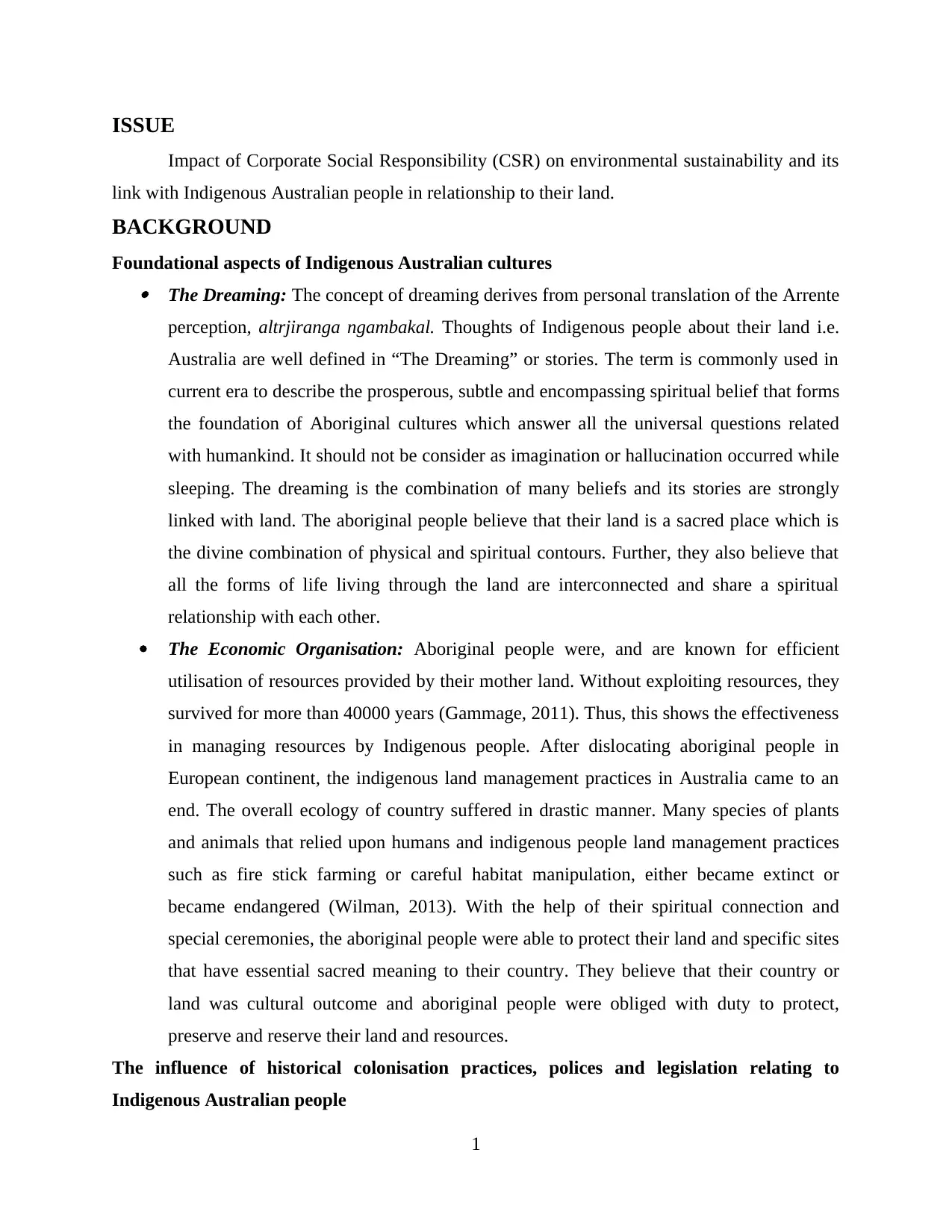
ISSUE
Impact of Corporate Social Responsibility (CSR) on environmental sustainability and its
link with Indigenous Australian people in relationship to their land.
BACKGROUND
Foundational aspects of Indigenous Australian cultures The Dreaming: The concept of dreaming derives from personal translation of the Arrente
perception, altrjiranga ngambakal. Thoughts of Indigenous people about their land i.e.
Australia are well defined in “The Dreaming” or stories. The term is commonly used in
current era to describe the prosperous, subtle and encompassing spiritual belief that forms
the foundation of Aboriginal cultures which answer all the universal questions related
with humankind. It should not be consider as imagination or hallucination occurred while
sleeping. The dreaming is the combination of many beliefs and its stories are strongly
linked with land. The aboriginal people believe that their land is a sacred place which is
the divine combination of physical and spiritual contours. Further, they also believe that
all the forms of life living through the land are interconnected and share a spiritual
relationship with each other.
The Economic Organisation: Aboriginal people were, and are known for efficient
utilisation of resources provided by their mother land. Without exploiting resources, they
survived for more than 40000 years (Gammage, 2011). Thus, this shows the effectiveness
in managing resources by Indigenous people. After dislocating aboriginal people in
European continent, the indigenous land management practices in Australia came to an
end. The overall ecology of country suffered in drastic manner. Many species of plants
and animals that relied upon humans and indigenous people land management practices
such as fire stick farming or careful habitat manipulation, either became extinct or
became endangered (Wilman, 2013). With the help of their spiritual connection and
special ceremonies, the aboriginal people were able to protect their land and specific sites
that have essential sacred meaning to their country. They believe that their country or
land was cultural outcome and aboriginal people were obliged with duty to protect,
preserve and reserve their land and resources.
The influence of historical colonisation practices, polices and legislation relating to
Indigenous Australian people
1
Impact of Corporate Social Responsibility (CSR) on environmental sustainability and its
link with Indigenous Australian people in relationship to their land.
BACKGROUND
Foundational aspects of Indigenous Australian cultures The Dreaming: The concept of dreaming derives from personal translation of the Arrente
perception, altrjiranga ngambakal. Thoughts of Indigenous people about their land i.e.
Australia are well defined in “The Dreaming” or stories. The term is commonly used in
current era to describe the prosperous, subtle and encompassing spiritual belief that forms
the foundation of Aboriginal cultures which answer all the universal questions related
with humankind. It should not be consider as imagination or hallucination occurred while
sleeping. The dreaming is the combination of many beliefs and its stories are strongly
linked with land. The aboriginal people believe that their land is a sacred place which is
the divine combination of physical and spiritual contours. Further, they also believe that
all the forms of life living through the land are interconnected and share a spiritual
relationship with each other.
The Economic Organisation: Aboriginal people were, and are known for efficient
utilisation of resources provided by their mother land. Without exploiting resources, they
survived for more than 40000 years (Gammage, 2011). Thus, this shows the effectiveness
in managing resources by Indigenous people. After dislocating aboriginal people in
European continent, the indigenous land management practices in Australia came to an
end. The overall ecology of country suffered in drastic manner. Many species of plants
and animals that relied upon humans and indigenous people land management practices
such as fire stick farming or careful habitat manipulation, either became extinct or
became endangered (Wilman, 2013). With the help of their spiritual connection and
special ceremonies, the aboriginal people were able to protect their land and specific sites
that have essential sacred meaning to their country. They believe that their country or
land was cultural outcome and aboriginal people were obliged with duty to protect,
preserve and reserve their land and resources.
The influence of historical colonisation practices, polices and legislation relating to
Indigenous Australian people
1
⊘ This is a preview!⊘
Do you want full access?
Subscribe today to unlock all pages.

Trusted by 1+ million students worldwide
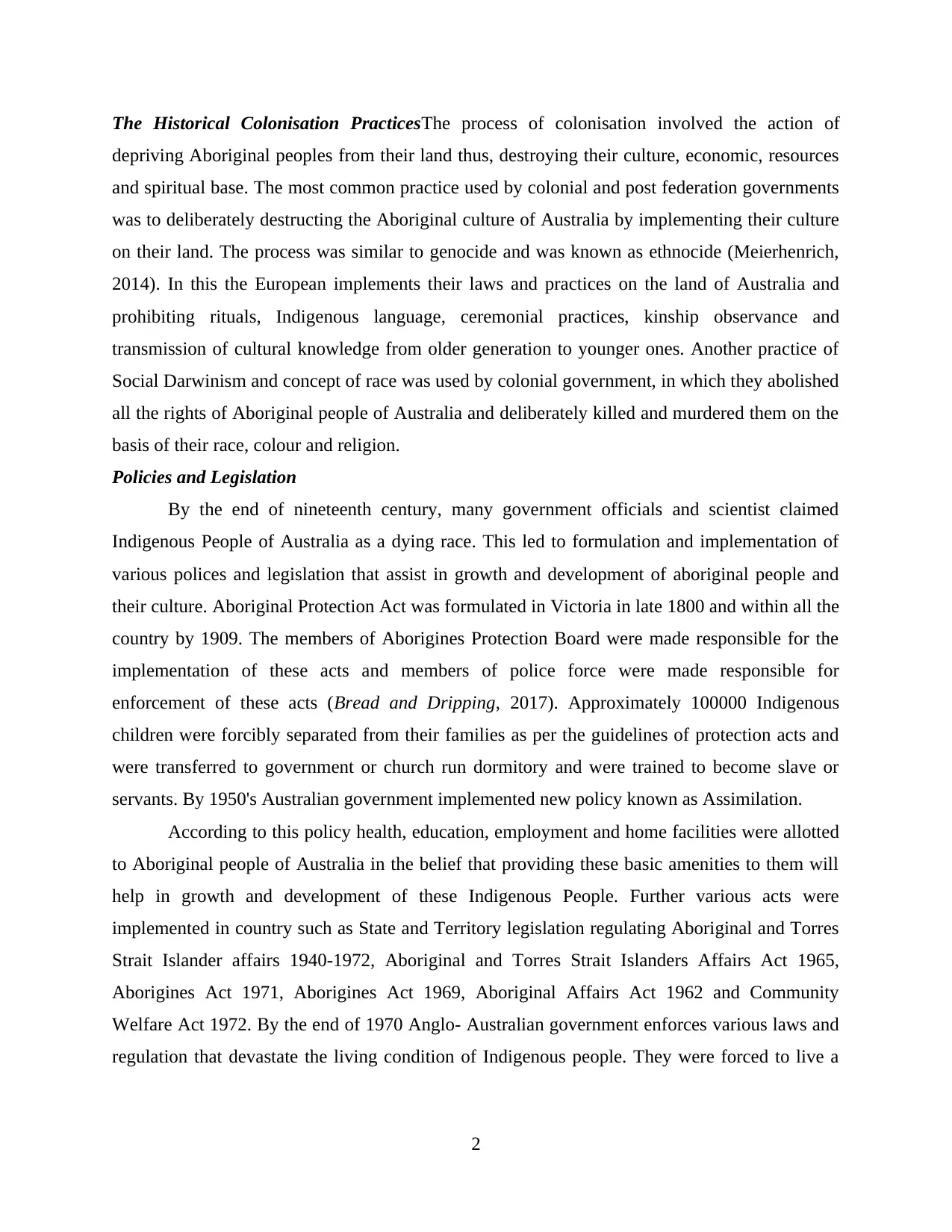
The Historical Colonisation PracticesThe process of colonisation involved the action of
depriving Aboriginal peoples from their land thus, destroying their culture, economic, resources
and spiritual base. The most common practice used by colonial and post federation governments
was to deliberately destructing the Aboriginal culture of Australia by implementing their culture
on their land. The process was similar to genocide and was known as ethnocide (Meierhenrich,
2014). In this the European implements their laws and practices on the land of Australia and
prohibiting rituals, Indigenous language, ceremonial practices, kinship observance and
transmission of cultural knowledge from older generation to younger ones. Another practice of
Social Darwinism and concept of race was used by colonial government, in which they abolished
all the rights of Aboriginal people of Australia and deliberately killed and murdered them on the
basis of their race, colour and religion.
Policies and Legislation
By the end of nineteenth century, many government officials and scientist claimed
Indigenous People of Australia as a dying race. This led to formulation and implementation of
various polices and legislation that assist in growth and development of aboriginal people and
their culture. Aboriginal Protection Act was formulated in Victoria in late 1800 and within all the
country by 1909. The members of Aborigines Protection Board were made responsible for the
implementation of these acts and members of police force were made responsible for
enforcement of these acts (Bread and Dripping, 2017). Approximately 100000 Indigenous
children were forcibly separated from their families as per the guidelines of protection acts and
were transferred to government or church run dormitory and were trained to become slave or
servants. By 1950's Australian government implemented new policy known as Assimilation.
According to this policy health, education, employment and home facilities were allotted
to Aboriginal people of Australia in the belief that providing these basic amenities to them will
help in growth and development of these Indigenous People. Further various acts were
implemented in country such as State and Territory legislation regulating Aboriginal and Torres
Strait Islander affairs 1940-1972, Aboriginal and Torres Strait Islanders Affairs Act 1965,
Aborigines Act 1971, Aborigines Act 1969, Aboriginal Affairs Act 1962 and Community
Welfare Act 1972. By the end of 1970 Anglo- Australian government enforces various laws and
regulation that devastate the living condition of Indigenous people. They were forced to live a
2
depriving Aboriginal peoples from their land thus, destroying their culture, economic, resources
and spiritual base. The most common practice used by colonial and post federation governments
was to deliberately destructing the Aboriginal culture of Australia by implementing their culture
on their land. The process was similar to genocide and was known as ethnocide (Meierhenrich,
2014). In this the European implements their laws and practices on the land of Australia and
prohibiting rituals, Indigenous language, ceremonial practices, kinship observance and
transmission of cultural knowledge from older generation to younger ones. Another practice of
Social Darwinism and concept of race was used by colonial government, in which they abolished
all the rights of Aboriginal people of Australia and deliberately killed and murdered them on the
basis of their race, colour and religion.
Policies and Legislation
By the end of nineteenth century, many government officials and scientist claimed
Indigenous People of Australia as a dying race. This led to formulation and implementation of
various polices and legislation that assist in growth and development of aboriginal people and
their culture. Aboriginal Protection Act was formulated in Victoria in late 1800 and within all the
country by 1909. The members of Aborigines Protection Board were made responsible for the
implementation of these acts and members of police force were made responsible for
enforcement of these acts (Bread and Dripping, 2017). Approximately 100000 Indigenous
children were forcibly separated from their families as per the guidelines of protection acts and
were transferred to government or church run dormitory and were trained to become slave or
servants. By 1950's Australian government implemented new policy known as Assimilation.
According to this policy health, education, employment and home facilities were allotted
to Aboriginal people of Australia in the belief that providing these basic amenities to them will
help in growth and development of these Indigenous People. Further various acts were
implemented in country such as State and Territory legislation regulating Aboriginal and Torres
Strait Islander affairs 1940-1972, Aboriginal and Torres Strait Islanders Affairs Act 1965,
Aborigines Act 1971, Aborigines Act 1969, Aboriginal Affairs Act 1962 and Community
Welfare Act 1972. By the end of 1970 Anglo- Australian government enforces various laws and
regulation that devastate the living condition of Indigenous people. They were forced to live a
2
Paraphrase This Document
Need a fresh take? Get an instant paraphrase of this document with our AI Paraphraser
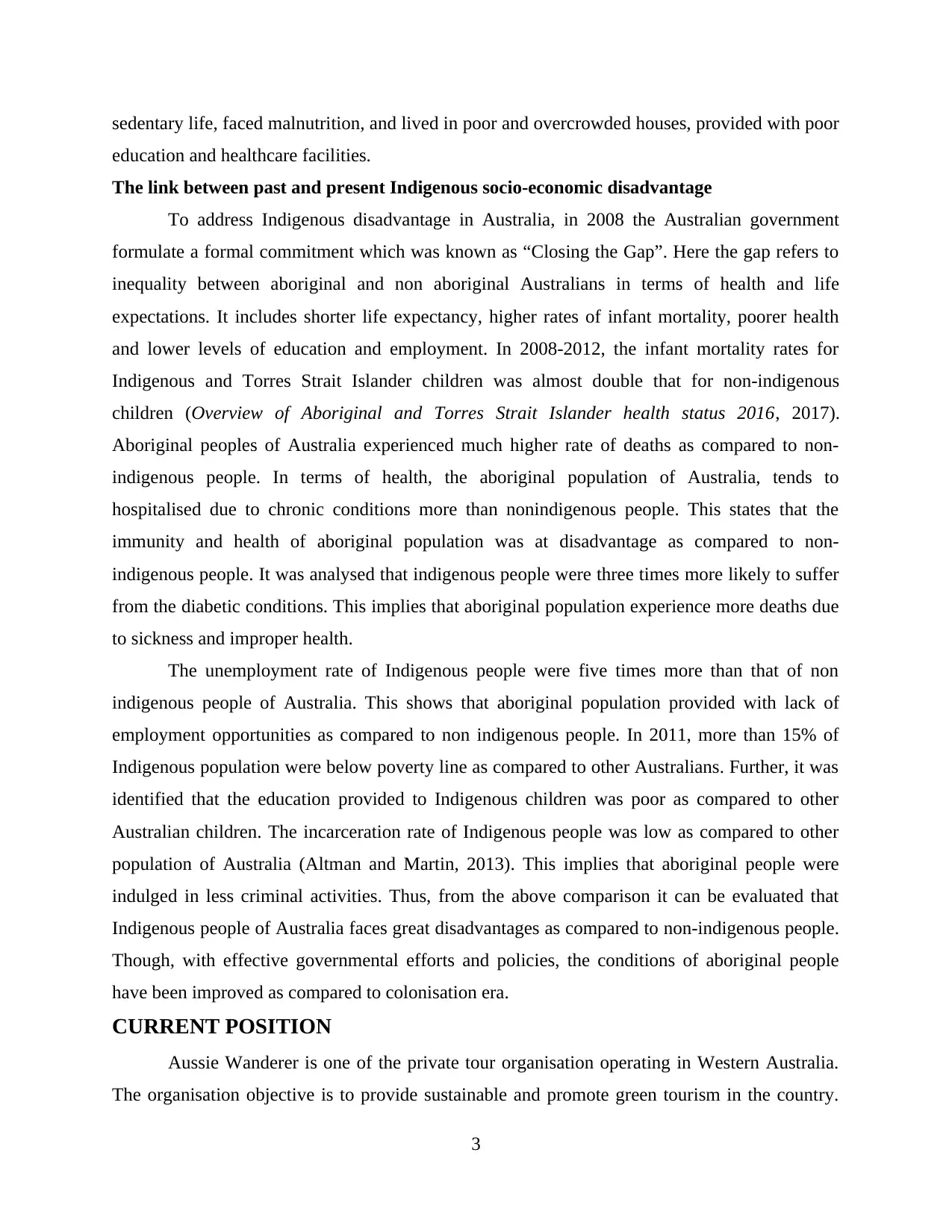
sedentary life, faced malnutrition, and lived in poor and overcrowded houses, provided with poor
education and healthcare facilities.
The link between past and present Indigenous socio-economic disadvantage
To address Indigenous disadvantage in Australia, in 2008 the Australian government
formulate a formal commitment which was known as “Closing the Gap”. Here the gap refers to
inequality between aboriginal and non aboriginal Australians in terms of health and life
expectations. It includes shorter life expectancy, higher rates of infant mortality, poorer health
and lower levels of education and employment. In 2008-2012, the infant mortality rates for
Indigenous and Torres Strait Islander children was almost double that for non-indigenous
children (Overview of Aboriginal and Torres Strait Islander health status 2016, 2017).
Aboriginal peoples of Australia experienced much higher rate of deaths as compared to non-
indigenous people. In terms of health, the aboriginal population of Australia, tends to
hospitalised due to chronic conditions more than nonindigenous people. This states that the
immunity and health of aboriginal population was at disadvantage as compared to non-
indigenous people. It was analysed that indigenous people were three times more likely to suffer
from the diabetic conditions. This implies that aboriginal population experience more deaths due
to sickness and improper health.
The unemployment rate of Indigenous people were five times more than that of non
indigenous people of Australia. This shows that aboriginal population provided with lack of
employment opportunities as compared to non indigenous people. In 2011, more than 15% of
Indigenous population were below poverty line as compared to other Australians. Further, it was
identified that the education provided to Indigenous children was poor as compared to other
Australian children. The incarceration rate of Indigenous people was low as compared to other
population of Australia (Altman and Martin, 2013). This implies that aboriginal people were
indulged in less criminal activities. Thus, from the above comparison it can be evaluated that
Indigenous people of Australia faces great disadvantages as compared to non-indigenous people.
Though, with effective governmental efforts and policies, the conditions of aboriginal people
have been improved as compared to colonisation era.
CURRENT POSITION
Aussie Wanderer is one of the private tour organisation operating in Western Australia.
The organisation objective is to provide sustainable and promote green tourism in the country.
3
education and healthcare facilities.
The link between past and present Indigenous socio-economic disadvantage
To address Indigenous disadvantage in Australia, in 2008 the Australian government
formulate a formal commitment which was known as “Closing the Gap”. Here the gap refers to
inequality between aboriginal and non aboriginal Australians in terms of health and life
expectations. It includes shorter life expectancy, higher rates of infant mortality, poorer health
and lower levels of education and employment. In 2008-2012, the infant mortality rates for
Indigenous and Torres Strait Islander children was almost double that for non-indigenous
children (Overview of Aboriginal and Torres Strait Islander health status 2016, 2017).
Aboriginal peoples of Australia experienced much higher rate of deaths as compared to non-
indigenous people. In terms of health, the aboriginal population of Australia, tends to
hospitalised due to chronic conditions more than nonindigenous people. This states that the
immunity and health of aboriginal population was at disadvantage as compared to non-
indigenous people. It was analysed that indigenous people were three times more likely to suffer
from the diabetic conditions. This implies that aboriginal population experience more deaths due
to sickness and improper health.
The unemployment rate of Indigenous people were five times more than that of non
indigenous people of Australia. This shows that aboriginal population provided with lack of
employment opportunities as compared to non indigenous people. In 2011, more than 15% of
Indigenous population were below poverty line as compared to other Australians. Further, it was
identified that the education provided to Indigenous children was poor as compared to other
Australian children. The incarceration rate of Indigenous people was low as compared to other
population of Australia (Altman and Martin, 2013). This implies that aboriginal people were
indulged in less criminal activities. Thus, from the above comparison it can be evaluated that
Indigenous people of Australia faces great disadvantages as compared to non-indigenous people.
Though, with effective governmental efforts and policies, the conditions of aboriginal people
have been improved as compared to colonisation era.
CURRENT POSITION
Aussie Wanderer is one of the private tour organisation operating in Western Australia.
The organisation objective is to provide sustainable and promote green tourism in the country.
3
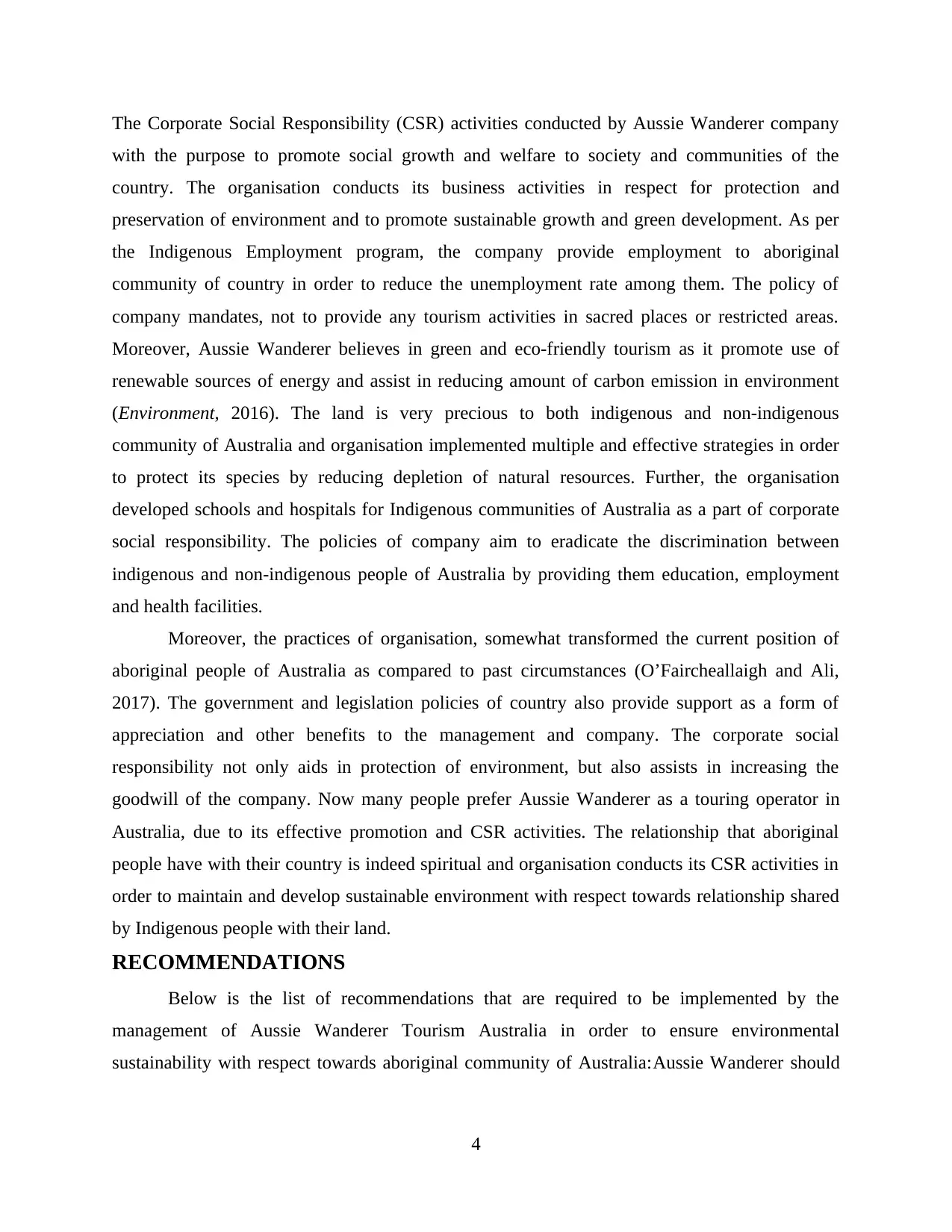
The Corporate Social Responsibility (CSR) activities conducted by Aussie Wanderer company
with the purpose to promote social growth and welfare to society and communities of the
country. The organisation conducts its business activities in respect for protection and
preservation of environment and to promote sustainable growth and green development. As per
the Indigenous Employment program, the company provide employment to aboriginal
community of country in order to reduce the unemployment rate among them. The policy of
company mandates, not to provide any tourism activities in sacred places or restricted areas.
Moreover, Aussie Wanderer believes in green and eco-friendly tourism as it promote use of
renewable sources of energy and assist in reducing amount of carbon emission in environment
(Environment, 2016). The land is very precious to both indigenous and non-indigenous
community of Australia and organisation implemented multiple and effective strategies in order
to protect its species by reducing depletion of natural resources. Further, the organisation
developed schools and hospitals for Indigenous communities of Australia as a part of corporate
social responsibility. The policies of company aim to eradicate the discrimination between
indigenous and non-indigenous people of Australia by providing them education, employment
and health facilities.
Moreover, the practices of organisation, somewhat transformed the current position of
aboriginal people of Australia as compared to past circumstances (O’Faircheallaigh and Ali,
2017). The government and legislation policies of country also provide support as a form of
appreciation and other benefits to the management and company. The corporate social
responsibility not only aids in protection of environment, but also assists in increasing the
goodwill of the company. Now many people prefer Aussie Wanderer as a touring operator in
Australia, due to its effective promotion and CSR activities. The relationship that aboriginal
people have with their country is indeed spiritual and organisation conducts its CSR activities in
order to maintain and develop sustainable environment with respect towards relationship shared
by Indigenous people with their land.
RECOMMENDATIONS
Below is the list of recommendations that are required to be implemented by the
management of Aussie Wanderer Tourism Australia in order to ensure environmental
sustainability with respect towards aboriginal community of Australia:Aussie Wanderer should
4
with the purpose to promote social growth and welfare to society and communities of the
country. The organisation conducts its business activities in respect for protection and
preservation of environment and to promote sustainable growth and green development. As per
the Indigenous Employment program, the company provide employment to aboriginal
community of country in order to reduce the unemployment rate among them. The policy of
company mandates, not to provide any tourism activities in sacred places or restricted areas.
Moreover, Aussie Wanderer believes in green and eco-friendly tourism as it promote use of
renewable sources of energy and assist in reducing amount of carbon emission in environment
(Environment, 2016). The land is very precious to both indigenous and non-indigenous
community of Australia and organisation implemented multiple and effective strategies in order
to protect its species by reducing depletion of natural resources. Further, the organisation
developed schools and hospitals for Indigenous communities of Australia as a part of corporate
social responsibility. The policies of company aim to eradicate the discrimination between
indigenous and non-indigenous people of Australia by providing them education, employment
and health facilities.
Moreover, the practices of organisation, somewhat transformed the current position of
aboriginal people of Australia as compared to past circumstances (O’Faircheallaigh and Ali,
2017). The government and legislation policies of country also provide support as a form of
appreciation and other benefits to the management and company. The corporate social
responsibility not only aids in protection of environment, but also assists in increasing the
goodwill of the company. Now many people prefer Aussie Wanderer as a touring operator in
Australia, due to its effective promotion and CSR activities. The relationship that aboriginal
people have with their country is indeed spiritual and organisation conducts its CSR activities in
order to maintain and develop sustainable environment with respect towards relationship shared
by Indigenous people with their land.
RECOMMENDATIONS
Below is the list of recommendations that are required to be implemented by the
management of Aussie Wanderer Tourism Australia in order to ensure environmental
sustainability with respect towards aboriginal community of Australia:Aussie Wanderer should
4
⊘ This is a preview!⊘
Do you want full access?
Subscribe today to unlock all pages.

Trusted by 1+ million students worldwide
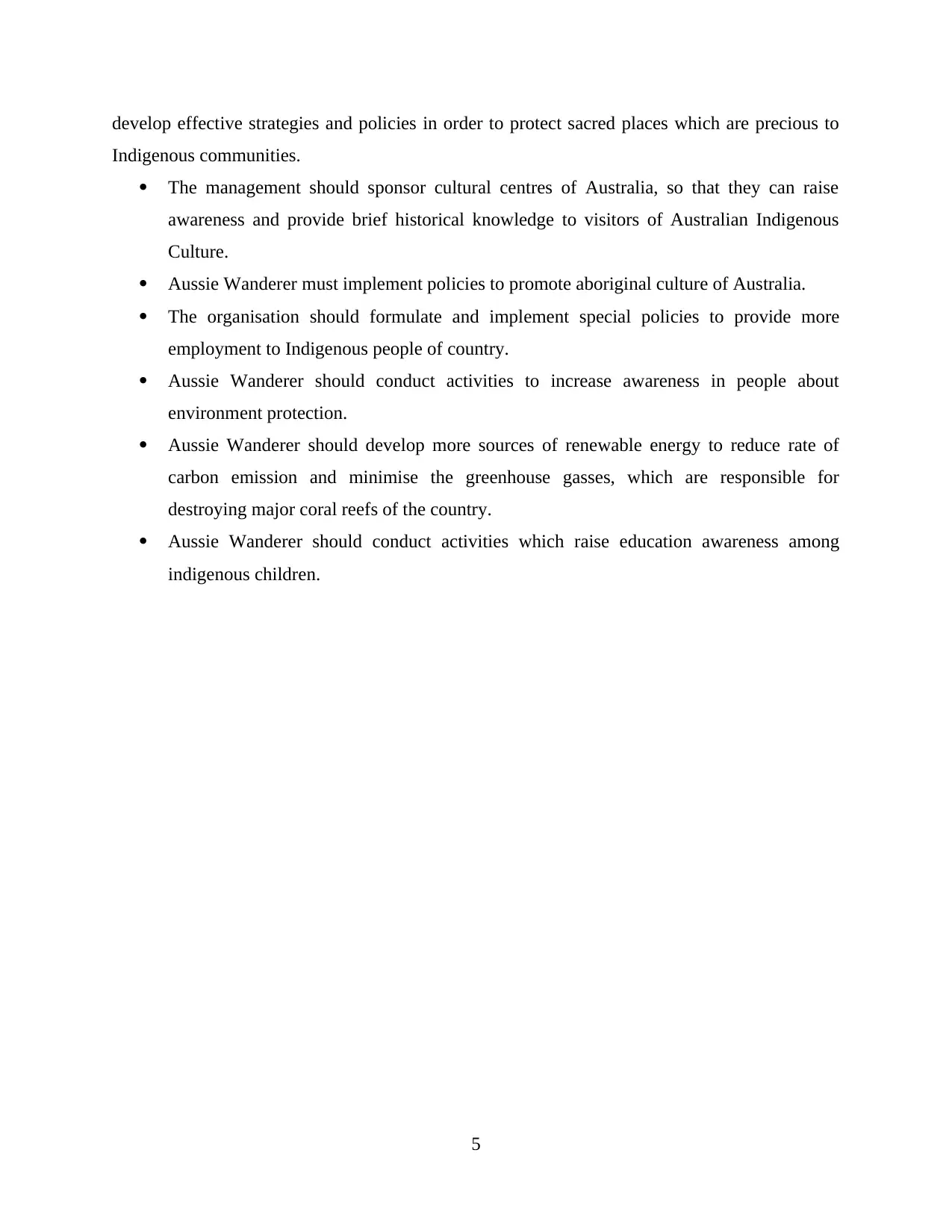
develop effective strategies and policies in order to protect sacred places which are precious to
Indigenous communities.
The management should sponsor cultural centres of Australia, so that they can raise
awareness and provide brief historical knowledge to visitors of Australian Indigenous
Culture.
Aussie Wanderer must implement policies to promote aboriginal culture of Australia.
The organisation should formulate and implement special policies to provide more
employment to Indigenous people of country.
Aussie Wanderer should conduct activities to increase awareness in people about
environment protection.
Aussie Wanderer should develop more sources of renewable energy to reduce rate of
carbon emission and minimise the greenhouse gasses, which are responsible for
destroying major coral reefs of the country.
Aussie Wanderer should conduct activities which raise education awareness among
indigenous children.
5
Indigenous communities.
The management should sponsor cultural centres of Australia, so that they can raise
awareness and provide brief historical knowledge to visitors of Australian Indigenous
Culture.
Aussie Wanderer must implement policies to promote aboriginal culture of Australia.
The organisation should formulate and implement special policies to provide more
employment to Indigenous people of country.
Aussie Wanderer should conduct activities to increase awareness in people about
environment protection.
Aussie Wanderer should develop more sources of renewable energy to reduce rate of
carbon emission and minimise the greenhouse gasses, which are responsible for
destroying major coral reefs of the country.
Aussie Wanderer should conduct activities which raise education awareness among
indigenous children.
5
Paraphrase This Document
Need a fresh take? Get an instant paraphrase of this document with our AI Paraphraser
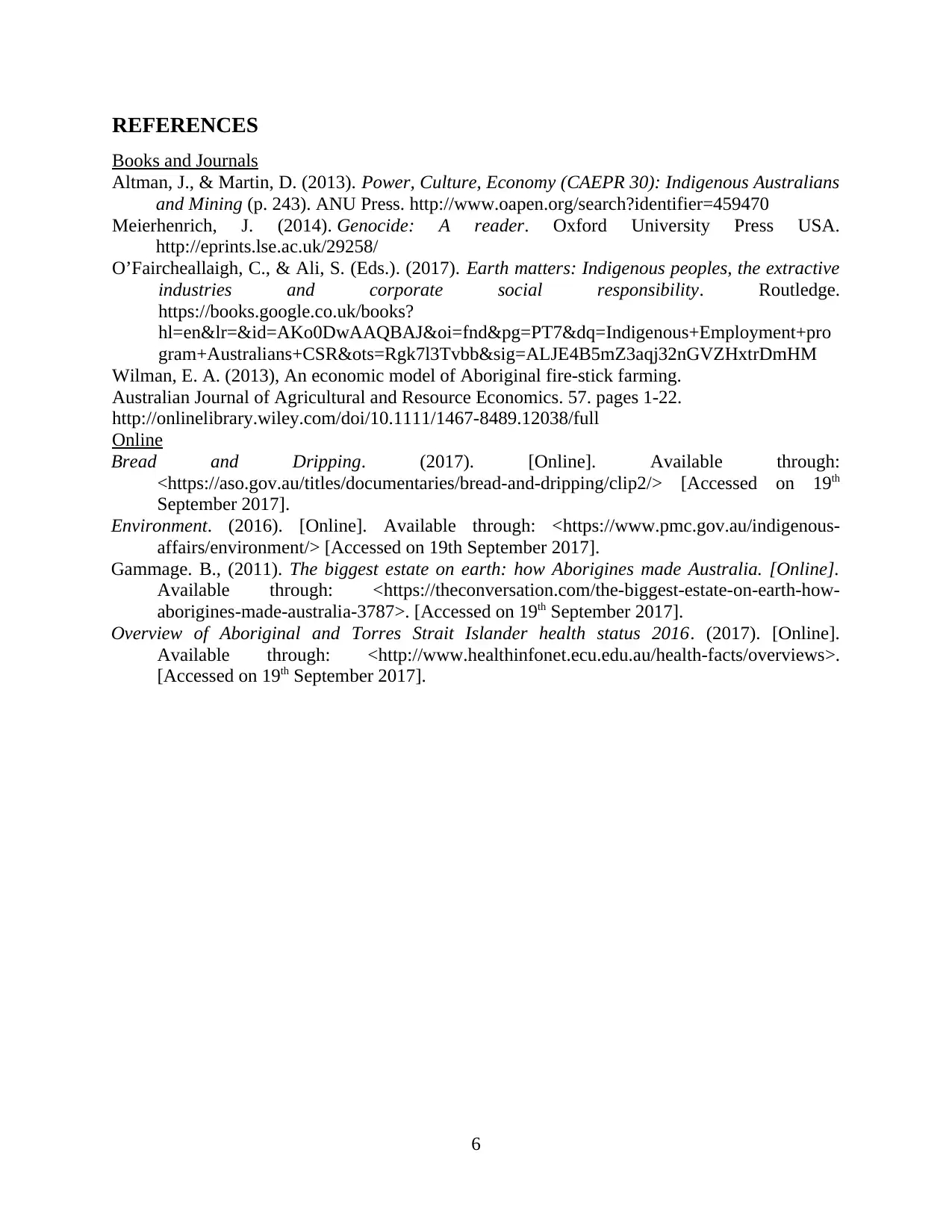
REFERENCES
Books and Journals
Altman, J., & Martin, D. (2013). Power, Culture, Economy (CAEPR 30): Indigenous Australians
and Mining (p. 243). ANU Press. http://www.oapen.org/search?identifier=459470
Meierhenrich, J. (2014). Genocide: A reader. Oxford University Press USA.
http://eprints.lse.ac.uk/29258/
O’Faircheallaigh, C., & Ali, S. (Eds.). (2017). Earth matters: Indigenous peoples, the extractive
industries and corporate social responsibility. Routledge.
https://books.google.co.uk/books?
hl=en&lr=&id=AKo0DwAAQBAJ&oi=fnd&pg=PT7&dq=Indigenous+Employment+pro
gram+Australians+CSR&ots=Rgk7l3Tvbb&sig=ALJE4B5mZ3aqj32nGVZHxtrDmHM
Wilman, E. A. (2013), An economic model of Aboriginal fire-stick farming.
Australian Journal of Agricultural and Resource Economics. 57. pages 1-22.
http://onlinelibrary.wiley.com/doi/10.1111/1467-8489.12038/full
Online
Bread and Dripping. (2017). [Online]. Available through:
<https://aso.gov.au/titles/documentaries/bread-and-dripping/clip2/> [Accessed on 19th
September 2017].
Environment. (2016). [Online]. Available through: <https://www.pmc.gov.au/indigenous-
affairs/environment/> [Accessed on 19th September 2017].
Gammage. B., (2011). The biggest estate on earth: how Aborigines made Australia. [Online].
Available through: <https://theconversation.com/the-biggest-estate-on-earth-how-
aborigines-made-australia-3787>. [Accessed on 19th September 2017].
Overview of Aboriginal and Torres Strait Islander health status 2016. (2017). [Online].
Available through: <http://www.healthinfonet.ecu.edu.au/health-facts/overviews>.
[Accessed on 19th September 2017].
6
Books and Journals
Altman, J., & Martin, D. (2013). Power, Culture, Economy (CAEPR 30): Indigenous Australians
and Mining (p. 243). ANU Press. http://www.oapen.org/search?identifier=459470
Meierhenrich, J. (2014). Genocide: A reader. Oxford University Press USA.
http://eprints.lse.ac.uk/29258/
O’Faircheallaigh, C., & Ali, S. (Eds.). (2017). Earth matters: Indigenous peoples, the extractive
industries and corporate social responsibility. Routledge.
https://books.google.co.uk/books?
hl=en&lr=&id=AKo0DwAAQBAJ&oi=fnd&pg=PT7&dq=Indigenous+Employment+pro
gram+Australians+CSR&ots=Rgk7l3Tvbb&sig=ALJE4B5mZ3aqj32nGVZHxtrDmHM
Wilman, E. A. (2013), An economic model of Aboriginal fire-stick farming.
Australian Journal of Agricultural and Resource Economics. 57. pages 1-22.
http://onlinelibrary.wiley.com/doi/10.1111/1467-8489.12038/full
Online
Bread and Dripping. (2017). [Online]. Available through:
<https://aso.gov.au/titles/documentaries/bread-and-dripping/clip2/> [Accessed on 19th
September 2017].
Environment. (2016). [Online]. Available through: <https://www.pmc.gov.au/indigenous-
affairs/environment/> [Accessed on 19th September 2017].
Gammage. B., (2011). The biggest estate on earth: how Aborigines made Australia. [Online].
Available through: <https://theconversation.com/the-biggest-estate-on-earth-how-
aborigines-made-australia-3787>. [Accessed on 19th September 2017].
Overview of Aboriginal and Torres Strait Islander health status 2016. (2017). [Online].
Available through: <http://www.healthinfonet.ecu.edu.au/health-facts/overviews>.
[Accessed on 19th September 2017].
6
1 out of 8
Related Documents
Your All-in-One AI-Powered Toolkit for Academic Success.
+13062052269
info@desklib.com
Available 24*7 on WhatsApp / Email
![[object Object]](/_next/static/media/star-bottom.7253800d.svg)
Unlock your academic potential
Copyright © 2020–2025 A2Z Services. All Rights Reserved. Developed and managed by ZUCOL.





